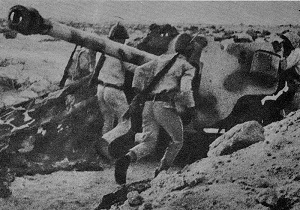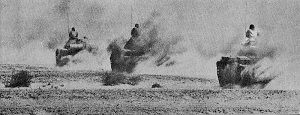 The Yom Kippur War was a war that occurred between Israel and a coalition of Arab nations, the war is sometimes known as the Ramadan War or October War. The Yom Kippur War lasted for 19 days, starting on the 6th October 1973 and finishing on October 25th of the same year.
The Yom Kippur War was a war that occurred between Israel and a coalition of Arab nations, the war is sometimes known as the Ramadan War or October War. The Yom Kippur War lasted for 19 days, starting on the 6th October 1973 and finishing on October 25th of the same year.
The war was short lived in duration but far reaching in its affect on the Middle East, affects which are still reverberating around the world today in one manner or another.
The Yom Kippur War is actually seen as a part of the Arab-Israeli war, a conflict that has been brewing in the region for around a hundred years.
Prior to the Yom Kippur War
The background of the Yom Kippur War can be traced back to the Six-Day War of 1967. A war that saw the Israeli’s capturing the Golan Heights from Syria, the West Bank and East Jerusalem from Jordan and the Sinai Peninsula from Egypt.
By October 1967 the Arab nations of Syria, Egypt and Jordan decided they wanted their lost lands back, this meant the nations colluded and came up with their three no’s, these were “no peace, no recognition and no negotiation with Israel”.
After this Israel spent hundreds of millions of dollars fortifying the land it had won, something it is still doing today.
By September 1970 the President of Egypt passed away and his successor was someone who was adamant on gaining the Sinai Peninsula back. This new President was called Anwar Sadat, Sadat said that peace negotiations could only occur if Israel withdrew its troops to the border line in place prior to the Six-Day War. This was something the Israelis would not commit to.
 After three years in office Sadat found the economy of Egypt on its knees and the people of Egypt calling for the Sinai Peninsula to be reclaimed, in fact many students carried out protests demanding action.
After three years in office Sadat found the economy of Egypt on its knees and the people of Egypt calling for the Sinai Peninsula to be reclaimed, in fact many students carried out protests demanding action.
Syria and Jordan were a bit more sceptical than Sadat who wished to wage war, in fact Syria and Jordan had grave concerns that they would lose more land if another conflict occurred.
Because of the situation at home and the fact that Israel declined Sadat’s peace negotiations in 1970, Sadat started a mass build up of Egyptian forces by purchasing Soviet fighter jets and tanks among other military hardware. Sadat even publicly said he would “sacrifice a million Egyptian soldiers” to gain the lost lands back.
The Yom Kippur War
Before the conflict started Egypt was feeding lost of false information to the Israeli’s this meant that Israel actually thought it unlikely that a conflict would start.
Just before the conflict started Egypt brought many troops up to the Suez Canal not too far from the Sinai Peninsula for a training exercise, well this is what many thought. The truth was that the training exercise was a ruse to be able to bring thousands of troops into the area without concerning the Israeli’s, this trick worked. Israel was a little confused why Syrian troops were also on the move to the border but still didn’t think a conflict would start.
The conflict was to start on October 6th on the Jewish Holiest of holy days called Yom Kippur, hence the conflicts name. The reason for this was because it was a day when Israel literally stops for a whole day, no work is carried out by anyone and everyone is greeting family and friends and carrying out religious functions.
The conflict started with 100,000 Egyptian soldiers crossing the Suez Canal with thousands of tanks, guns and heavy mortars. On the Israeli side there were only around 450 troops stationed in a number of small fortifications, these were supported by 290 tanks.
In the first two days the Egyptians made a bridgehead and moved men and hardware over the canal, these two days saw the Israeli’s try to beat them back through attacks by their armoured forces. Because the attack was not expected the Israeli’s were unable to use their Air Force to great effect and the Egyptian and Syrian forces were left unopposed from aerial attacks for the first few days.
From now until the 13th October the Israeli’s continued counter attacked to try and force the Egyptians back. The issue was the Egyptians had made their position a good defensive one and the Israeli forces did not wish to advance too far out of range of their surface to air missile sites.
The tide changed from the 18th till the 23rd October when the Israeli forces made a strong counter attack against the Egyptians and managed to force the Egyptians so far back that the Israeli forces were not only able to cross the Suez Canal into Egypt, they were nearly all the way to Cairo.
While this was all going on the UN passed a resolution with the backing of the United States and Soviet Union for a cease-fire to occur, this was on the 23rd October. Although the cease-fire came into effect at night, it really didn’t have an impact at first as the Israeli lines were stretched and pockets of Egyptian and Israeli forces left behind on the Peninsula were still fighting. This meant the cease-fire line could not be seen and no one could tell where to place it.
Interestingly the Israelis even continued moving south in Egypt even after the resolution, something that was found out when Soviet planes flew over. The Soviets were not happy and the Americans were perplexed. By this time the Israelis had essentially put the Egyptian third army into a Kessel, they were surrounded.
The Americans saw this as a good way for building relationships with Egypt as the Egyptians would need the US help to stop their soldiers being slaughtered. The US put heavy pressure on the Israelis to retreat back, they even went as far as telling the Israeli’s that they may support the UN in ensuring Israel retreated back to the pre 22nd October positions.
 What many didn’t know is that the Third Army was actually in a stronger position than first thought and continued to defend itself admirably.
What many didn’t know is that the Third Army was actually in a stronger position than first thought and continued to defend itself admirably.
While all this was going on in Egypt the Syrian forces were attacking Israeli forces in the Golan Heights using aircraft, artillery and tanks. For four days the Syrian forces advanced and the Israeli forces buckled under the pressure of the stronger Syrian force. After this though tides changed and Israeli forces were joined by more reserve forces, from October the 12th the Israeli forces pushed the Syrian forces so far back that they crossed the border and Israeli forces were gaining ground in Syria.
The gains in Syria ground to a halt when Iraq and Jordan sent thousands of troops in support of Syria.
The war also included small scale naval battles between torpedo boats of Syria, Egypt and Israel. This was short lived as the Israeli’s blew up both Syrian and Egyptian boats.
By October the 24th the Soviets grew to a point of anger and sent a letter telling the US that they need to join forces and send in troops to ensure a ceasefire and that if the US did not comply then the Soviet Union would send its own troops in as support for Egypt.
The US became nervous at this letter and put pressure on the Egyptians to decline Soviet intervention, they also raised their Defcon rating from 4 to 3.
On October 24th the UN passed Resolution 339 for a ceasefire and while most of the forces did stop there were still battles raging on until the 28th October with airstrikes on the Third Army of Egypt and light arms battles.
On October 28th talks occurred between Israeli and Egyptian Major Generals and UN checkpoints were put in place, the war effectively ended. This is three days after the actual end date of the war.

after reading this article, I still don’t understand why the Yom Kippur war started in the first place. If yous could please help me out, I would appreciate it!
Well Jez from research I have found on the Yom Kippur war is that the Egyptians and Syrians wanted the land taken from them during the Six Day War and because Israel would not sign ‘Resolution 242’ to give the land back, Egypt and Syria planned a suprise attack on Israel and started a war against them which Israel would have lost without the U.S’s support in the form of the airlift codenamed ‘Nickel Grass’. But because the U.S sent support King Faisal of Saudi Arabia who was providing money to the Arab war effort soon after set up an embargo on Saudi Arabia’s oil trade to America.